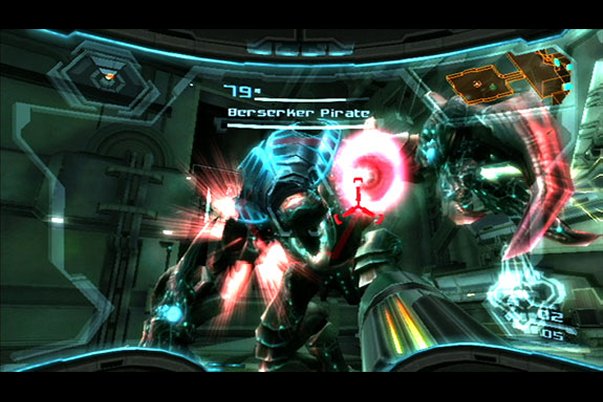The History of Metroid
A series that lived in the shadows of giants
Meanwhile at Intelligent Systems, development on the long-awaited Game Boy Advance sequel, Metroid Fusion was progressing smoothly. For the first time in years Team Shikamaru had reunited especially for the Metroid project, and was going to be the most accessible, plot-heavy instalment yet.
Fusion took Samus back to SR-388 (where she'd earlier exterminated the Metroids) where she swiftly became infected by X Parasites, the galactic pandemic that Metroids were originally created to destroy. Samus was saved by surgical removal of her armour and infusion with Metroid DNA, allowing her to absorb X Parasites for health. The consequence was the creation of an evil Samus clone, who constantly stalked you throughout the game.
Objective based gameplay made for the a far more linear Metroid than had been seen before, and Team Shikamaru hoped it would finally help them sell a few more copies in Japan.
In North America Retro Studios' public image - and expectations for Metroid Prime - got worse and worse. The developer's final non-Metroid project, Raven Blade was officially canned and staff moved over to help reach the deadline for Metroid Prime. Then a series of embarrassing photographs of led founder Jeff Spangenberg to resign from the company. Miyamoto and Japan stepped in.
A year later Metroid Prime re-emerged - this time playable and in first-person at E3 2002. Expectations were totally and completely blown away; the controversial sequel successfully retained the classic Metroid formula while moving it into a 3D environment.
Nintendo called it a First-Person Adventure; seamless and beautiful HUD effects immersed the player in Samus' world like never before, registering everything from rain effects to the bounty hunter's own reflection in her visor. But glimpses of the famous Varia suit weren't completely removed; morph ball antics were flawlessly moved into first-person and many of Metroid's famous items survived the move into first-person.
Sign up to the GamesRadar+ Newsletter
Weekly digests, tales from the communities you love, and more

At the end of that year both Metroid Fusion and Metroid Prime arrived in North America in the same week, both receiving rave reviews. But it was Prime that turned out to be the real winner,garnering tons of game of the year awards and becoming the second highest selling title on GameCube. Metroid had finally become a success, and Nintendo quickly moved in to purchase Retro outright and commission a trilogy.
The second game in the Prime series, Metroid Prime 2: Echoes arrived in record time just two years later, receiving a similarly stellar reception - but suffering from the competition of Microsoft's much-hyped Halo 2.
The game saw Samus explore the moody planet Aether, a battered world split into light and dark dimensions by the twisted race Ing. Meanwhile Dark Samus roamed the planet unchecked, a reincarnation of the long defeated Metroid Prime.
The Metroid revival continued with Metroid Zero Mission, a surprise remake of the NES original, and NST's Hunters, a first-person spin-off designed to show of the 3D hardware of the Nintendo DS. Positive reaction from pack-in demos with the new handheld caused Nintendo to pour extra development resources into the project and Hunters managed positive reviews thanks to its solid online modes, but failed to impress in the sales department.
Retro farmed the DS game to NST for a good reason: it was about to embark on its biggest game yet for Nintendo's next console...
Metroid Prime 3: Corruption was the first game to be shown running on Wii hardware, a proof of concept that Nintendo's radical new control method could be used to make the most accurate and smooth console shooters yet.
Thanks to the Wii remote, players can now aim Samus's weapon with the flick of a wrist, and traditional series items such as the grapple beam can be taken to levels of interactivity previously impossible on old hardware.
It's also the taken longer to develop than any of the Metroid games to date (it was originally planned for the Wii launch). It missed itsprojection by almost a year, but since then the gain in quality is blatantly obvious, and it retains a standard thatmay beregardedas the best yet in the acclaimed Prime series.
Prime 3 was one the of Wii's post-launch triple-A titles. Maybe, finally, Metroid's learnt to be at the right place and the right time...


